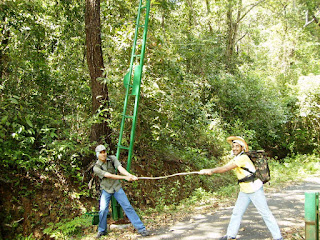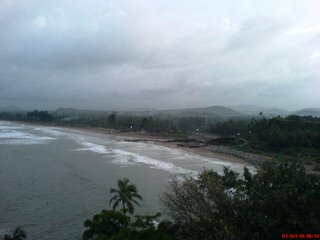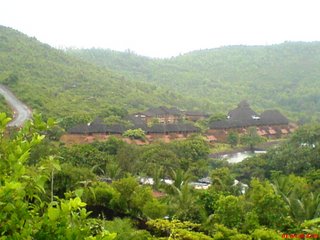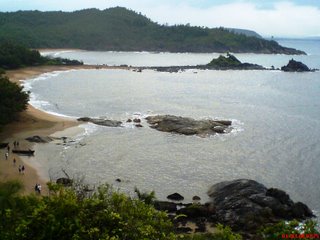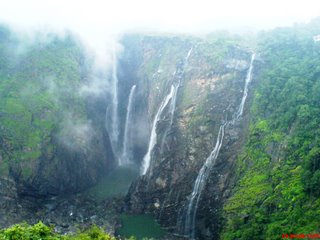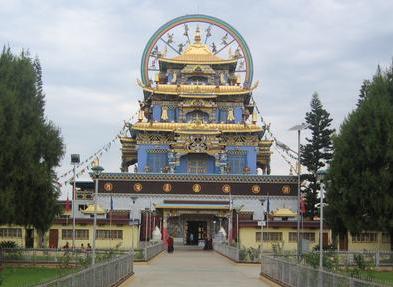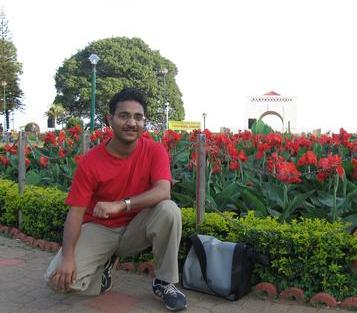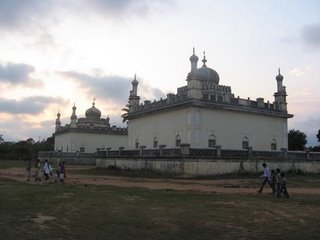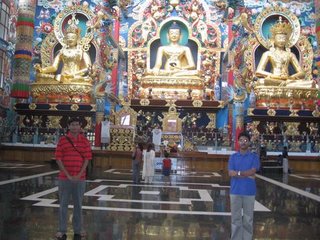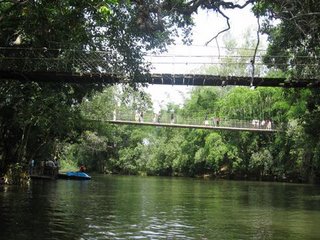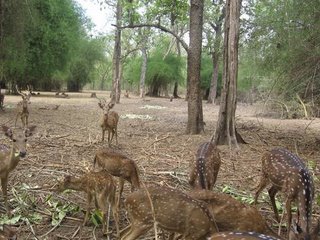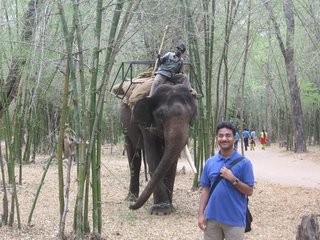
Kudremukh Peak lies in the Western Ghat Range in state of Karnataka and after which the Kudremukh National Park (KNP) and Kudremukh Iron Ore Co. are named.
Why indeed we (Hrishikesh, Brajesh and I Mohit) should be drawn to Kudremukh when we did not have trek-worthy maps, equipments and experience can perhaps only be explained by pictures of these valleys' trademark lush-green carpeted slopes interspersed with thick forested creeks. Nevertheless, this blog will sufficiently disenchant you so that the very name ‘Kudremukh’ shall send a shudder to your spine next time....
http://www.karnatakawildernesstourism.org/Trekking_opp_in/Kudremukh.htm
How to Reach from Mangalore:
* Mangalore to Beltangady (64 km; Rs 31; 2 hr) on NH-13 to Chikmaglur (Dist. HQ in Karnataka not far from Mangalore);
* Beltangady to Navoor (12 km; Rs 10; 20 mins);
* Navoor to Navoor FRH (3 km; Auto Rs. 30);
* Navoor FRH to Kudremukh Peak (18 km trek; take your own sweet time)
24 December 2006 (Might as well have been our last day!)
We had little idea of the Kudremukh-trek’s length and terrain’s difficulty and only knew how to reach the Forest Rest House (FRH) where we expected more guidance. Please take note of how we managed to do most of the things pretty wrong in the start itself:
· Began late from Mangalore Bus terminal at 0745.
· Caught a dilapidated govt bus which ensured we didn't catch a wink for 2 hours, courtesy its state-of-the-art Indian Dolby surround-sound system.
· Overshot Beltangady town by 5kms to reach Ujire and then returned back. At Beltangady, we waited for half an hour, sitting in a private bus, watching it getting stuffed with villagers and their stuff. Once it did start, the next 20 minutes till Navoor village were intimately body-hugging and soul-lifting throughout.
· We walked 3kms from Navoor (where the private bus unboarded us) to the Navoor Forest Rest House (FRH), when we could have simply picked an auto-rickshaw.
· Instead of the anticipated night-pass and guidance for Kudremukh National Park at FRH, we found it locked. ( “If something can go wrong, it will” - Murphy)
After a brief rest at the locked FRH’s altar, we fortunately met a young village chap – Prasanna. This is when we first came to know that Tholali Anti-Poaching Camp (APC) is 12 kms from Navoor FRH and Kudremukh Peak is another 6km further from APC. Also, some Gowda families near Tholali rent out their huts for a night halt. Thanking him, we estimated that that Tholali should be comfortably reached by sun-set. (This day-dreaming was to cost us a dreaded wakeful night later!)
Soon after the FRH we came across the open gate and noted down the Phone number on the board posted some distance away, though Kannada script was incomprehensible to us. The road ahead was metalled and wide but winding. Therefore, once we came across the 0.5 km stone-mound mark, we decided to abandon the winding road and venture into the much steeper and shorter jungle trails which reassuringly crisscrossed the winding road frequently. This was a fine arrangement and we thought that if the road was 12 kms to Tholali APC, the trail will only be lesser, quicker and sporting!
There were no leeches fortunately as rainy season had ended a few months back but the flip side was that the sun was in top form and the jungle was dry.
Slowly, several things began to dawn upon us, each more horrifying than the previous in its import:
Our jungle trek reassuringly crossed the road several times which meant we were on the right track. However, while the lower section of the road was wide and metalled, the upper sections had pitifully crumbled and sported ferns instead of tyre-marks – which meant that the road was not frequented of late at the upper sections of the hill.
The jungle trail too had become much narrow and there were instances where the visibility was less than a meter as several knee-high plants and waist-high grasses had shadowed the boulder-ridden tracks. So, neither rangers nor villagers nor poachers nor encroachers or what have you, came this way either.
Meanwhile, our stock of 3 litres of water had shrunk to just 1 litre and all the waterfalls that we went past had dried up!
Then puzzlingly the jungle trail did not cross the road again!! We do not know for sure whether the road had ended or not as we only remembered that we had crossed the road last time half an hour ago. Anyways, returning back was not much of an option and we decided to continue on our trail further.
For some time, the milestone mounds were coming on the jungle trek as well, and we had to confront the truth that Tholali APC was not 12 kms by road (that too, if the road went till there at all) but 12 kms by this jungle trek and we were still at just 5 km mark!
So, we decided to do some SWOT analysis:
Strength - we are in this together, the trail is ahead of us, the milestones indicate how far we have come from Navoor FRH and we have got adequate ration and sleeping bags.
Weakness – we were in Kudremukh Park without a night-permit, the milestone mounds do not convey how far we have to go or if we were still on the right path, we had little water; the metalled road had gone missing, no mobile connectivity, no human habitation, no arms or torch or tents and increasingly weary legs.
Opportunities – glimpse of Kudremukh Peak and valleys
Threat – Neither the wildlife (rather, a few monkeys did cheer us up) nor the thought of sleeping in the jungle bothered me as much as the fact that the area was Naxalite-ridden (local fire-brand militants); and that an encounter with Naxalite or a case of mistaken identity might not make it to the newspaper editor’s desks!
To put it in a nutshell – we were in a soup.
As we dragged ourselves tight-lipped over the uphill trek, all of a sudden, we heard the lovely sound of fellow beings. We soon exchanged greetings with 2 villagers who were on their way down. In the absence of a common language, Brajesh used some basic Kannada and they too sportingly used some rudimentary English. The good news was that water was available 1 km further at the other side of the hill. The bad news was that Tholali was indeed 12 kms from Navoor by jungle trek and there would be the same uphill trek throughout, without a single habitation to be seen till Tholali.
By 7 km milestone-point, we were arguing whether we would be able to reach Tholali but Brajesh was clear – we were not stopping midway. So we ascended higher – a waterfall here, a spectacular vista there. However, our legs were aching and nothing is more dangerous in an uphill climb than legs rebelling against you even as precipices accompany you throughout.
At 9 km point, when I felt that my knees and tendons had begun to disobey me, even though only slightly, I decided to put my foot down literally. Thankfully by now, Hrishikesh and Brajesh too concurred. So, at 9 km point, a little away from a waterfall and on the trek’s path itself, we dropped down and unloaded. It was 04:30 pm and there was enough time to reach Tholali but our legs refused to carry us further.
And yet, after some massage, we decided to sportingly check our surroundings. The path crossed a small waterfall a little further and there was a 9.25 km mound just before another steep climb began. As we were not game for any more steep climbs, we returned back.

As the night descended, the jungle seems to have acquired life. Some wild cats dueled in the nearby waterfall as perhaps to who shall have me over for dinner (I being the meatiest of us three), and the trees silhouetted against the dark-grey sky rustled even without any perceivable wind as though whispering our accurate geographic locations to all who cared to listen. I was amazed at the tricks a dark eerie jungle can play with even a sane and alert conscience – quite an indelible experience for me. This was indeed a characteristic Christmas Eve, “Silent night, holy night; all is calm, all is bright”!
Turn by turn, we all took guard. The idea was simple – one guy will sleep soundly, one guy will remain vigilant with a stick and knife and the other guy will chatter with him occasionally in the beginning for him to acclimatize with the darkness. The wind was unbearably cold and the vigilant needed two jackets though the sleeping bags were cozy enough.
After just 4 hours of sleep from 11 PM to 3 AM, in which Hrishikesh had been a brave vigilant, they again woke me up and I again remained groggily wakeful till 6 PM, when I decided to kick Brajesh out of the sleeping back. He had occupied the bag successfully for 12 hours! The sky was slightly iridescent at the horizon though it was still not dawn yet when Brajesh finally decided to do his bit for the next 2 hours.
25 December 2006:
Me and Hrishikesh woke up amongst truly beautiful sunlit valleys and stretched ourselves fit. Brijesh had taken several morning snaps by now. The joy was writ large on our faces and all the tiredness and pessimism of the previous day had disappeared much the same way as dews were gone with kiss of the first sun-rays. Today was Christmas and also my birthday! We had bought a plum cake in the beginning, and this was truly the most bizarre birthday I ever celebrated, the others being once in train and another in a railway stationJ.

Therafter we walked another mile before we pulled up an auto and then the bus from Navoor point to Beltangady town… we reached Mangalore city by 3:30 PM.
The next morning, the newspapers’ front-pages featured the news of a certain notorious Naxalite named Gowda, shot down in the other region of the same Kudremukh National Park while his other two female companions escaped. The anti-Naxalite forces had fired at his refuge in the bushes as they saw a flickering torchlight, and later in the morning recovered his body and ammunitions. Ironically, it seems to have been fortunate for us, not to have packed even something as basic as a torch with us since we too did not have a night-permit nor could comprehend local dialect nor Indian Forces follow such niceties before 'ambushing' make-believe Naxalites.

Woods are lovely, dark and deep,
But there are warnings to heed!
And miles to go before you peak…
And miles indeed, for I know what I speak.


